Crete
Crete, the largest of the Greek islands, is some 250km long and 57km across at its widest point. The landscape is dominated by mountains, which are sufficiently high for the winter and spring rains to fall as snow that remains visible until well into spring on the highest peaks.
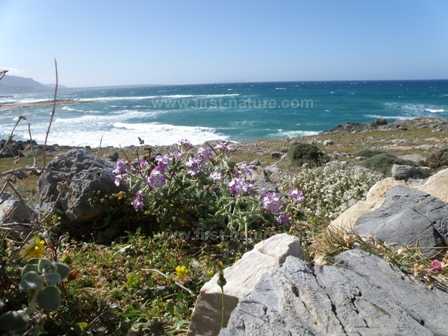
The northern coast of Crete
The north coast of Crete has small coastal plains punctuated with bays and beaches; it is much more densely populated than the southern coast which has mountains that generally drop straight into the sea and therefore has far fewer plains, coves and beaches.
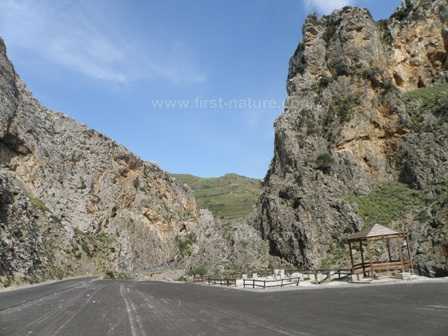
The Kourtaliotiko Gorge
The island is dominated by a backbone of mountains. In the west lie the White Mountains, in the centre of the island are the Idi Mountains, and to the east the Diki Mountains loom over the landscape. Within the mountains there are numerous cave systems, steep and rocky gorges, and large areas of plateaux or 'basins' surrounded by mountains, and the plateaux retain moisture for longer periods of the year than other parts of the island. As a consequence, these flat areas are floristically richer, with some species that are not found in other parts of Crete. The most notable of the gorges is the Gorge of Samaria, which is the longest in Europe, whilst the most important of the plateaux from a botanical point of view are the Lasithi (in the east), Omalos (in the centre) and Nidha, also in the centre of Crete on Mount Ida.
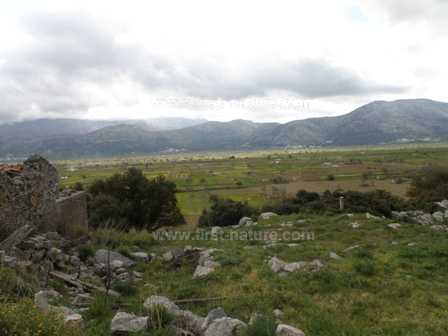
Spring on the Lasithi Plateau
The peak time to visit Crete to see the wildflowers is from February until the end of April, when the landscape quickly becomes parched and brown with very little sign of the botanical wonders that appeared in the earlier months of the year. The earliest of the orchid species appear in February, and these include the magnificent Giant Orchid (Himantoglossum robertianum) and a few of the much less conspicuous Ophrys fusca species and subspecies. They are quickly followed by an explosion of wildflower,s which peaks in March and April.
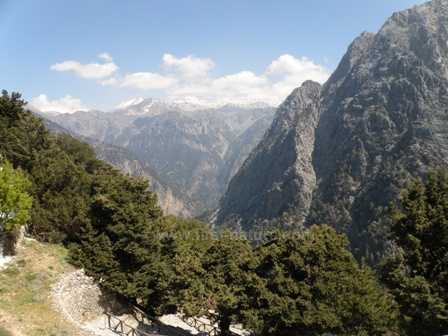
The Gorge of Samaria
The weather in spring can be unpredictable. Warm sunny days can be interspersed with torrential rainstorms and bitterly cold and strong winds, but the bad weather seldom lasts long and the sun soon puts in an appearance again. Up in the mountains, home to many of the most beautiful wildflowers, the weather is always changeable and a warm sunny day on the coast may deteriorate into cold winds, thick fog and rain as you start to climb higher and higher. It is wise to be armed with warm clothing and raincoats in case things take a sudden turn for the worse, and sensible walking shoes or boots are essential for mountain foray,s where the going can be rocky and steep and very slippery in wet weather.

South coast of Crete at Frangokastello
There are plenty of cafes and hotels in the villages throughout the mountains so there are places to take shelter, but they may not all be open until the main tourist season, which begins long after most of the wildflowers have disappeared. It is perfectly feasible to stay in hotels on the coasts and travel inland to the mountains, gorges and plateaux, but travelling time is greatly increased by the winding, switchback nature of the roads into the mountains, and a two or three location holiday will enable you to shorten daily travelling times considerably.
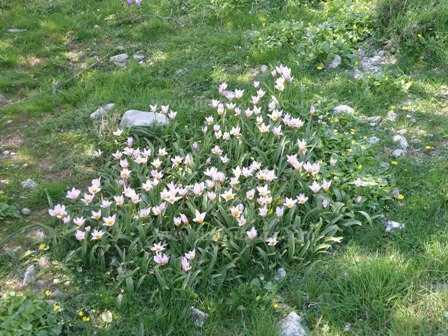
Wild tulips on the Omalos Plateau
No trip to see the wildflowers of Crete would be complete without a visit to the hills around Spili, a village situated more or less in the centre of Crete, about 30 kilometres south of Rethymnon. Many rare and endemic species can be seen in this area, including between 25 and 30 orchid species.

Up to 30 wild orchids occur on this small hill near Spili
Food in Crete is excellent, but to make the budget stretch a bit further it is better to avoid restaurants in the obviously tourist-trap locations. Fish is plentiful but expensive. Soups, salads and excellent cooked vegetable dishes abound and are very reasonable in price, as are some of the more familiar Greek dishes such as souvlaki (kebabs) and mousaka (layers of meat, aubergines and potatoes with a light cheese topping), which are all readily available and delicious. Something special to look out for in the spring is a vegetable dish referred to by Cretans as 'greens' - a mixture of plants harvested from the wild and cooked together in various combinations. Depending on what is growing at any given time, the dish may include wild sorrel leaves and even wild asparagus; they are served warm with a drizzle of olive oil and a squeeze of lemon juice. No trip to Crete can be complete without at least one dish of the sublime Cretan yoghurt served with mountain honey or black cherries in syrup!

Greek yoghurt with mountain honey
Cretan wine is also very good, and most restaurants will serve local red and white wines by the pitcher or jug, which is a much cheaper way of buying it than by the bottle. Ouzo is a great aniseed-flavoured aperitif and is served with water, and wherever you go, you will be given a complimentary glass (or more!) of raki after your meal, but be warned: it is powerful stuff!
Orchids seen in Crete, with locations
Species name |
Common name |
Location |
|
| Anacamptis laxiflora | Lax-flowered Orchid | Spili | Orchidaceae |
| Anacamptis papilionacea | Pink Butterfly Orchid | Lassithi | Orchidaceae |
| Anacamptis pyramidalis | Pyramidal Orchid | Lassithi,Spili | Orchidaceae |
| Himantoglossum robertianum | Giant Orchid | Lassithi | Orchidaceae |
| Ophrys bombyliflora | Bumblebee Orchid | Spili | Orchidaceae |
| Ophrys candica | White Ophrys | Plakias | Orchidaceae |
| Ophrys cretensis | Ophrys cretensis | Nr. Heraklion | Orchidaceae |
| Ophrys cretica | Cretan Ophrys | Spili | Orchidaceae |
| Ophrys dyris/Omegaifera | Omega Ophrys | Spili | Orchidaceae |
| Ophrys episcopalis | Bishop's Ophrys | Lassithi | Orchidaceae |
| Ophrys fusca | Sombre Bee Orchid | Spili | Orchidaceae |
| Ophrys gortynia | Ophrys gortynia | Plakias | Orchidaceae |
| Ophrys iricolor | Rainbow Ophrys | Spili | Orchidaceae |
| Ophrys phryganae | Phrygana Ophrys | Throughout | Orchidaceae |
| Ophrys sicula | Ophrys sicula | Throughout | Orchidaceae |
| Ophrys sphegodes subsp. spruneri | Grecian Spider Orchid | Spili | Orchidaceae |
| Ophrys tenthredinifera | Sawfly Orchid | Lassithi, Spili | Orchidaceae |
| Orchis anthropophora | Man Orchid | Spili | Orchidaceae |
| Orchis fragrans | Bug Orchid | Orchidaceae | |
| Orchis italica | Naked Man Orchid | Throughout | Orchidaceae |
| Orchis lactea | Milky Orchid | Spili | Orchidaceae |
| Orchis pauciflora | Sparse-flowered Orchid | Spili | Orchidaceae |
| Orchis quadripunctata | Four-spotted Orchid | Lassithi, Spili | Orchidaceae |
| Orchis sitiaca | Orchis sitiaca | Spili | Orchidaceae |
| Neotinea tridentata | Toothed Orchid | Lassithi | Orchidaceae |
| Serapias lingua | Tongue Orchid | Spili | Orchidaceae |
| Serapias orientalis | Eastern Tongue Orchid | Hersonissos | Orchidaceae |
| Serapias parviflora | Small-flowered Serapias | Orchidaceae |